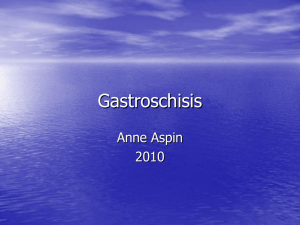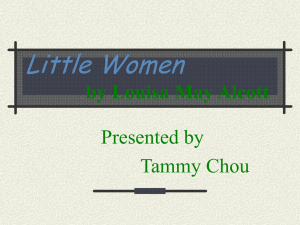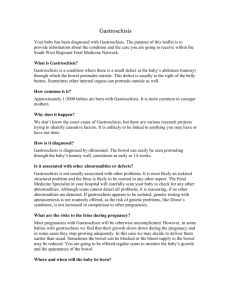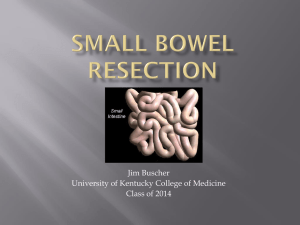Fetal Anomalies
advertisement
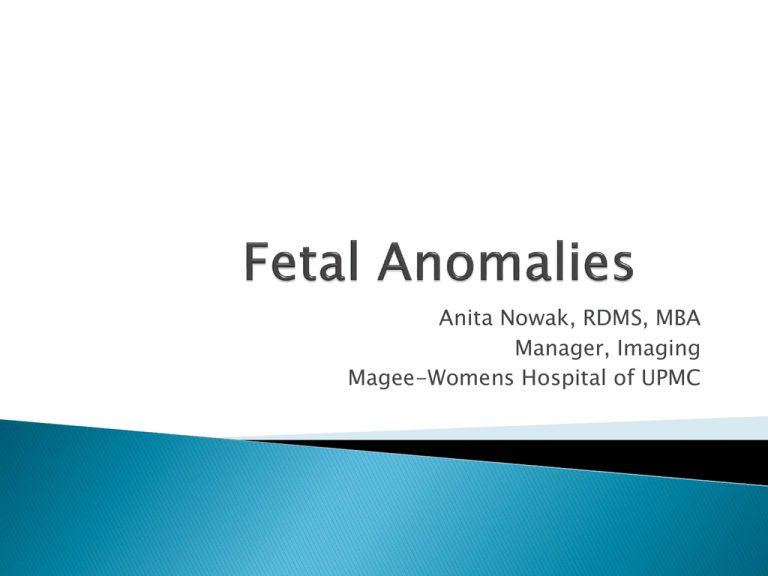
Anita Nowak, RDMS, MBA Manager, Imaging Magee-Womens Hospital of UPMC Anencephaly Spina Bifida Cleft Lip Gastroschisis/Omphalocele Trisomy 18 Conjoined Twins Looking at Ultrasounds is very much like looking at clouds Use your imagination to find the cat in the ultrasound The absence of the cranial vault If early in pregnancy, brain tissue can be seen Head has an irregular shape There is no soft tissue seen above the orbits Face – eyes appear “frog like” There are many forms of neural tube defects, Spina Bifida is the most common of the central nervous system A midline defect of the vertebrae that results in exposure of the contents of the neural canal Can be genetic Meningocele ◦ Anechoic cystic mass ◦ Rarely covered by skin ◦ Does not contain neural tissue Myelomeningocele ◦ Complex cystic mass ◦ Contains neural tissue Chiari II Malformation seen in 99% of cases ◦ Absent cisterna magna “Banana Sign” Abnormal cerebellum Ventriculomegaly Lemon shaped calvarium 2nd most common congenital malformation Estimated to be 1:700 live births 50% both lip and palate are defective Can be caused by both genetic and environmental factors 97% of the time it is an isolated finding Occurs shortly after 3rd week of gestation when the grooves that separate the structures that form the primitive oral cavity persist, they would normally be obliterated by normal growth. Most commonly seen is a unilateral cleft Upper lip defect on nose/mouth view Gastroschisis is a paraumbilical defect of the anterior abdominal wall. Incidence ranges from 1:10,000 to 1:15,000 Is not associated with an increased risk of other anomalies Not usually associated with a chromosomal abnormality Normal umbilical cord insertion site Small bowel loops seen in the amniotic cavity No covering membrane over the loops of bowel Can include stomach and large bowel Majority occur to the right of the umbilical cord A ventral wall defect where there is herniation of the intraabdominal contents into the base of the umbilical cord Unlike gastroschisis, there is a membrane covering these contents Estimated to occur in 1:5800 to 1:5130 Most cases are sporadic Unlike gastroschisis this condition IS often associated with a chromosomal abnormality Umbilical cord insertion is typically midline on the mass Located centrally Typically the contents of the mass are liver and small bowel; however, other abdominal organs can be present Also called Edwards Syndrome There are three 18th chromosomes instead of two Multiple major anomalies are seen Occurs in approximately 1:2500 pregnancies 50% carried to term will be stillborn Of those that survive, only 10% survive to their first birthday Not genetic – typically occur sporadically Clenched Hands Choroid plexus cysts “Strawberry” shaped head Intrauterine growth restriction Cardiac defects Micrognathia Low set ears Incidence is 1:50,000 to 1:100,000 Sporadic event caused by an incomplete division of the embryonic cell mass Different types of conjoined twins ◦ Craniopagus – joined at the brain ◦ Thoracopagus – joined at the heart ◦ Omphalopagus – Xiphopagus – joined at the abdomen ◦ Pygopagus – joined at the buttocks and lower spine ◦ Ischiopagus – joined at the hips Joined on any portion of the skull except the face Share the bones of the cranium Have two trunks, four arms and legs Most common form of conjoined twins Congenital heart disease found in 75% of cases The union always includes the heart Most frequent abnormality is a conjoined heart with two ventricles and a varying number of atria Attached in the lower abdomen Remain facing each other throughout the exam Joined at the buttocks and lower spine Face away from each other Have one anus, two rectums, four arms and legs Joined end to end with the spine in a straight line Four arms and a variable number of legs Have only one external genitalia
